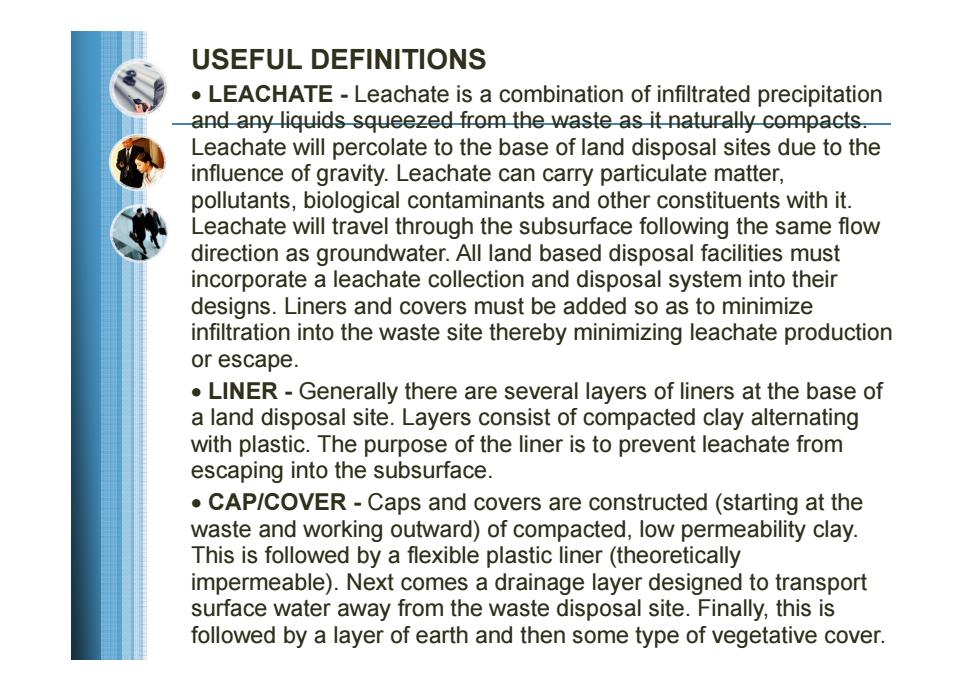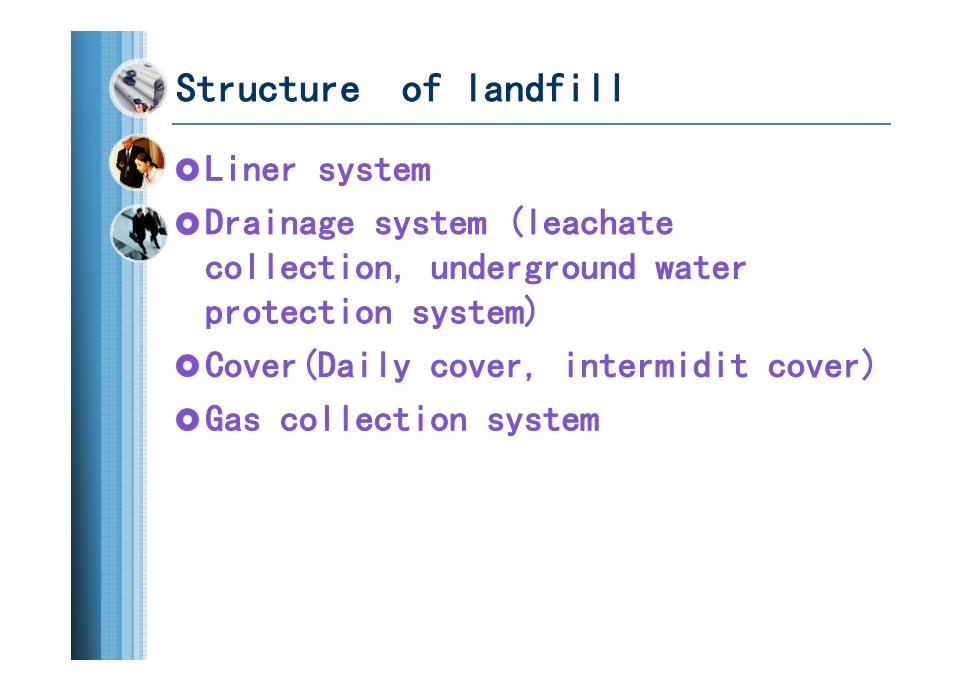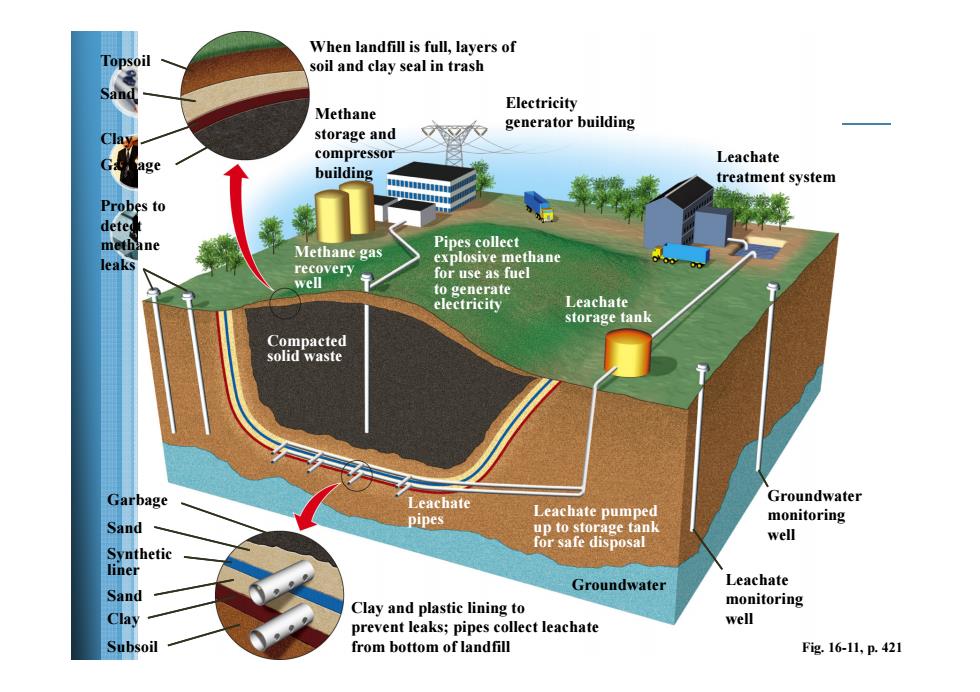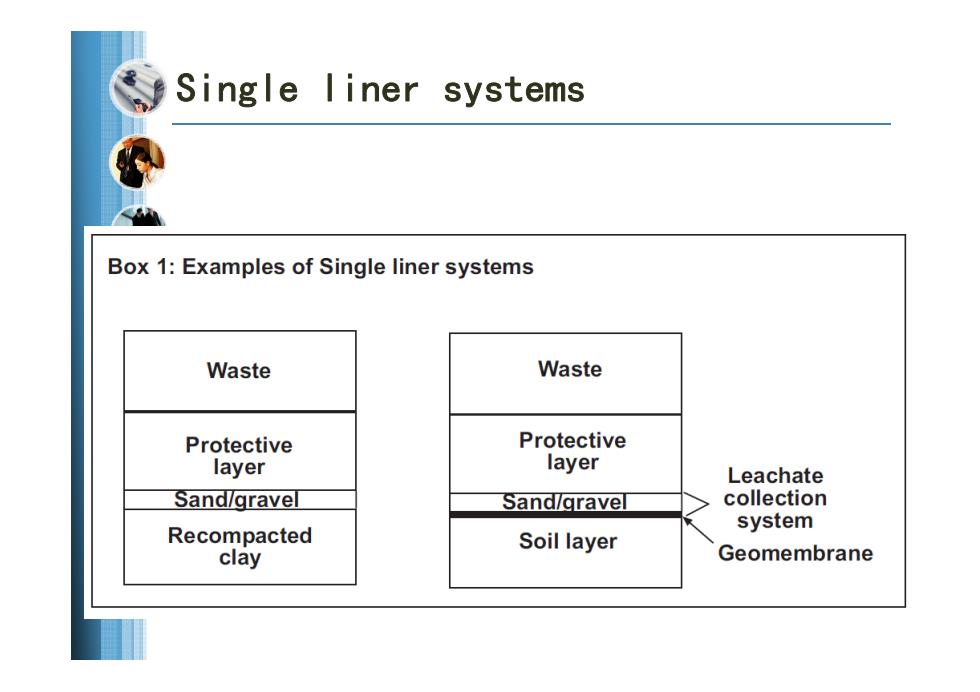
Sanitary Landfills Engineering principles used to: confine waste to smallest practical area reduce waste to smallest practical volume cover waste with layer of compacted soil (or tarps)each day(finishing cover is ~50 cm or more of compacted clay-rich soil) NOTE:Compaction and subsidence will continue after site is closed;any further development must be able to accommodate these potential problems. S.Hughes 2000
S. Hughes 2000 Sanitary Landfills Engineering principles used to: • confine waste to smallest practical area • reduce waste to smallest practical volume • cover waste with layer of compacted soil (or tarps) each day (finishing cover is ~50 cm or more of compacted clay-rich soil) NOTE: Compaction and subsidence will continue after site is closed; any further development must be able to accommodate these potential problems

USEFUL DEFINITIONS LEACHATE-Leachate is a combination of infiltrated precipitation and any liquids squeezed from the waste as it naturally compacts. Leachate will percolate to the base of land disposal sites due to the influence of gravity.Leachate can carry particulate matter, pollutants,biological contaminants and other constituents with it. Leachate will travel through the subsurface following the same flow direction as groundwater.All land based disposal facilities must incorporate a leachate collection and disposal system into their designs.Liners and covers must be added so as to minimize infiltration into the waste site thereby minimizing leachate production or escape LINER-Generally there are several layers of liners at the base of a land disposal site.Layers consist of compacted clay alternating with plastic.The purpose of the liner is to prevent leachate from escaping into the subsurface. CAP/COVER-Caps and covers are constructed(starting at the waste and working outward)of compacted,low permeability clay. This is followed by a flexible plastic liner(theoretically impermeable).Next comes a drainage layer designed to transport surface water away from the waste disposal site.Finally,this is followed by a layer of earth and then some type of vegetative cover
USEFUL DEFINITIONS LEACHATE - Leachate is a combination of infiltrated precipitation and any liquids squeezed from the waste as it naturally compacts. Leachate will percolate to the base of land disposal sites due to the influence of gravity. Leachate can carry particulate matter, pollutants, biological contaminants and other constituents with it. Leachate will travel through the subsurface following the same flow direction as groundwater. All land based disposal facilities must incorporate a leachate collection and disposal system into their designs. Liners and covers must be added so as to minimize infiltration into the waste site thereby minimizing leachate production or escape. LINER - Generally there are several layers of liners at the base of a land disposal site. Layers consist of compacted clay alternating with plastic. The purpose of the liner is to prevent leachate from escaping into the subsurface. CAP/COVER - Caps and covers are constructed (starting at the waste and working outward) of compacted, low permeability clay. This is followed by a flexible plastic liner (theoretically impermeable). Next comes a drainage layer designed to transport surface water away from the waste disposal site. Finally, this is followed by a layer of earth and then some type of vegetative cover

Structure of landfill oLiner system ODrainage system (leachate col lection,underground water protection system) oCover(Daily cover,intermidit cover) OGas col lection system
Structure of landfill Liner system Drainage system (leachate collection, underground water protection system) Cover(Daily cover, intermidit cover) Gas collection system

When landfill is full,layers of soil and clay seal in trash Electricity Methane generator building storage and compressor Leachate building treatment system Pipes collect Methane gas explosive methane recovery for use as fuel well to generate electricity Leachate storage tank Compacted solid waste Garbage Leachate Groundwater Leachate pumped pipes monitoring up to storage tank well for safe disposal nthetic Groundwater Leachate Clay and plastic lining to monitoring prevent leaks;pipes collect leachate well Subsoil from bottom of landfill Fig.16-11,p.421
Fig. 16-11, p. 421 When landfill is full, layers of soil and clay seal in trash Topsoil Sand Electricity generator building Clay Garbage Methane storage and compressor building Leachate treatment system Probes to detect methane leaks Pipes collect explosive methane for use as fuel to generate electricity Methane gas recovery well Leachate storage tank Compacted solid waste Garbage Leachate pipes Leachate pumped up to storage tank for safe disposal Groundwater monitoring well Synthetic liner Leachate monitoring well Sand Groundwater Clay Clay and plastic lining to prevent leaks; pipes collect leachate Subsoil from bottom of landfill Sand

Single liner systems Box 1:Examples of Single liner systems Waste Waste Protective Protective layer layer Leachate Sand/gravel Sand/gravel collection Recompacted system Soil layer clay Geomembrane
Single liner systems